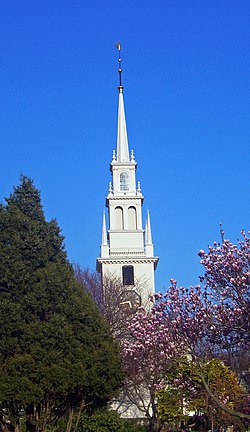Trinity Episcopal Church (Newport, Rhode Island)
|
Trinity Church
|
|

Front view of church and steeple, 2008
|
|
| Location | Queen Anne Square, Newport, Rhode Island |
|---|---|
| Coordinates | 41°29′15″N 71°18′50″W / 41.48750°N 71.31389°WCoordinates: 41°29′15″N 71°18′50″W / 41.48750°N 71.31389°W |
| Built | 1726/1698 |
| Architect | Richard Munday |
| Architectural style | Georgian |
| Part of | Newport Historic District (#68000001) |
| NRHP reference # | 68000004 |
| Significant dates | |
| Added to NRHP | November 24, 1968 |
| Designated NHL | November 24, 1968 |
| Designated NHLDCP | November 24, 1968 |
Trinity Church, on Queen Anne Square in Newport, Rhode Island, is a historic parish church in the Episcopal Diocese of Rhode Island. Founded in 1698, it is the oldest Episcopal parish in the state. The current Georgian building was designed by architect Richard Munday and constructed in 1725–26. It is a National Historic Landmark.
The Newport, Rhode Island congregation began to gather about 1698. When Richard Coote, 1st Earl of Bellomont was investigating charges of the infractions of the Navigation Acts in Rhode Island, he requested that the Board of Trade send a minister from England to Rhode Island. The first church structure was built in 1700.
The present church building was constructed in 1725–26, designed by local builder Richard Munday, who based his designs on those that he had seen that Sir Christopher Wren had used in London churches in the late 17th century. The church's design is very similar to that of Old North Church in Boston. Trinity, however, was built entirely of wood. It is believed to be the only church building with its three-tiered wineglass pulpit remaining in its original position in the center of the aisle, in front of the altar. The building was enlarged in 1764, but otherwise retains its original character with box pews.
In 1731, Dean George Berkeley donated the first organ, whose wooden case, decorated with the Crown of England and the mitres of the archbishops of Canterbury and York, survives in place. The first organist was Charles Theodore Pachelbel, son of the famous German Baroque composer Johann Pachelbel.
...
Wikipedia


